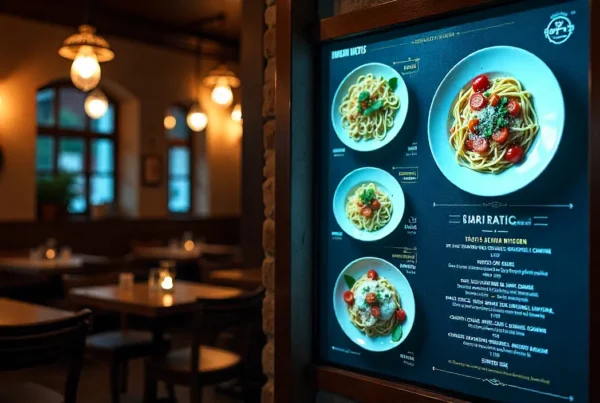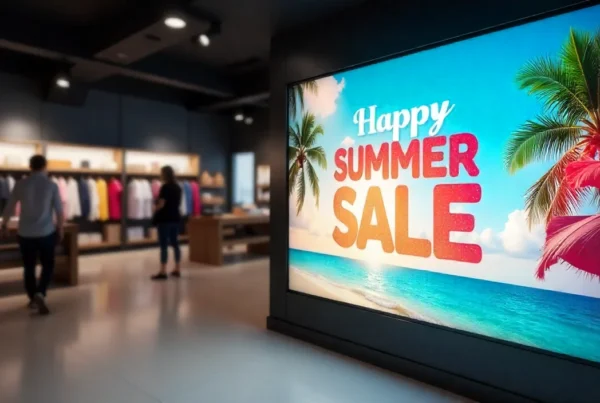Touch screen software powers everything, whether it is self-order kiosks and digital exhibits, salon check-ins, or classroom boards. The hardware is in the limelight, yet the software is what coordinates gestures, layouts, security, and analytics and answers the age-old question, “Is a touchscreen hardware or software?” It’s both, working in sync. This guide demonstrates how to select, design, and implement the right platform across industries without skipping a beat.

What Is Touch Screen Software (and How It Works)
Touchscreen software is designed specifically to interpret gestures and react quickly, as well as to maintain an interface that is easy to navigate. Combine it with the appropriate panel and player, and you have a flexible, dependable system that can be used publicly or privately, i.e., interactive touch screen software that makes any screen a two-way surface.
Gesture Intelligence
Recognizes taps, long presses, swipes, pinches, rotations, and handwriting—mapping touch points to UI actions in milliseconds.
Visual Feedback & Micro-interactions
Confirmation Highlights, ripples, animated state changes, and tactile cues (where possible) communicate, “Your touch landed,” and minimize input errors.
Touch-First UI/UX
Large targets, wide spacing, clear hierarchies, and controls that you can reach with your thumbs—the interface is designed to be controlled by fingers, not mice.
Hardware–Software Symbiosis
Is it touch screen hardware or software? It is a stack: sensors-> drivers/OS-> the app. The application interprets raw XY data, applies gesture logic, and executes the command.
Key Types & Use Cases (What to Deploy Where)
Touch Screen Kiosk Software
Lock a device to one experience, avoid OS tampering, and make sessions confidential. Superior kiosk software can be used in touch screen installations to enable check-in, ticketing, wayfinding, and self-service returns.
Touch Screen Presentation Software
In classrooms, boardrooms, and events, add notes, move 3D models, open polls, and pass control to audience devices, transforming lectures into collaborations.
Touch Screen Digital Signage Software
Combine dynamic playlists with on-screen interactions (filters, product finders, wayfinding). Some teams refer to this digital signage touch screen software when the interactivity is in the center.
Restaurant Touch Screen Software
Tableside ordering, allergen views, modifiers, and POS-synced pricing that will switch in real time. KDS and queue screens connect the entire flow.
Touch Screen Salon Software
Front-desk check-in, stylist schedules, consent forms, and lookbooks that clients can peruse. Encourage retail upselling and loyalty registration at the checkout.
Cultural & Public Spaces
Museum Touch Screen Software
It is used to create high-resolution artifacts, launch schedules, captioned video, and augmented reality tie-ins without damaging delicate items. Optimal discovery without choking.

Multi-Touch Screen Software
Tables and walls that can support numerous hands simultaneously—urban planning, architecture pin-ups, interactive maps, and multi-user games.
Free Software Touchscreen Software
The DIY and R&D teams prototype fast, customize intensely, and manage costs. Fits perfectly in pop-ups, labs, and specialized kiosks.
Platform Choices & Compatibility
Touch Screen Software for Windows
Common in enterprise and retail to support drivers, device management, and kiosk mode (assigned access). Fits with peripherals (scanners, printers, payment).
Cross-Platform Options
Android is a value-added and easily serviceable platform; Linux is a stable and small-footprint platform; and HTML5 is a browser-first platform. Match with your player hardware and governance model.
Design It Right (So People Actually Use It)
Touch Screen Design Software
Design touch flows on Figma/XD/Sketch, and test on actual hardware. Test reach, glare, and parallax; make sure that the targets are at least 44 px and labels can be read at a distance.
Rules that convert
Short (10-20s) loops, one message per screen, and progressive disclosure on deep dives. Use haptics/animation sparingly to prevent fatigue.
Accessibility by Default
Large contrast, captioned media, screen-reader support (where OS allows), and distinct focus states. The touch designs must be functional for all hands.
Must-Have Features (Across Any Vertical)
Reliability & Uptime
Offline caching, graceful recovery, and watchdogs. Communal surfaces require around-the-clock resiliency.
Security & Privacy
Kiosks and salons must have lockdown, session resets, role-based access, data encryption, and remote wipe.
Remote Management
Monitor device health, push updates, rotate content, and collect logs, all without rolling a truck.
Integrations & Analytics
It works with POS/CRM/inventory, calendars, beacons, and webhooks. Event logs and funnels inform you of what visitors actually touch.
Implementation Playbook (Pilot → Scale)
Start with a targeted pilot (24 weeks) in your most impactful zone. Use instruments to measure rates of completion and staff feedback. Standardize templates and scale on waves. Select governance up front to ensure the touch screen software update is prompt and consistent across sites.

Make Every Tap Count
Share your application (kiosk, signage, classroom, museum, salon, restaurant), hardware limitations, and KPIs. We can pair a platform—touch screen kiosk software, touch screen digital signage software, or interactive touch screen presentation software—and chart a rollout that is secure, measurable, and a pleasure to use.
FAQs: Touch Screen Software
Is a touch screen hardware or software?
Both. The panel feels a touch; drivers/OS read the signals; touch screen software translates them into actions. All levels should be synchronized to be precise and quick.
Can I lock a device for single-purpose use?
Yes—use touch screen kiosk software (a.k.a. kiosk software for touch screens) to lock down the machine, auto-logout sessions, and disallow OS access.
We run Windows—what’s the path of least resistance?
Use touch screen software on Windows with Assigned Access, device management, and a breadth of drivers. Perfect when you require peripherals and enterprise controls
How is digital signage different from an app?
Passive playlists are signage; interactive flows require touch screen digital signage software (sometimes referred to as digital signage touch screen software) to allow visitors to browse, filter, and act.
Do you support multi-user collaboration?
Yes—select multi-touch screen software on tables/walls that monitors numerous touch points at a time.
Are there options for museums, restaurants, and salons?
Yes: museum touch screen software to explore the museum, restaurant touch screen software to order, and KDS and touch screen salon software for booking and retail.
Can I start with free tooling?
You can experiment with open-source touch screen software; you just have to plan on the time to set up, update, and harden security.
How do I design interfaces that people actually touch?
Touch screen design software should be used to prototype and then run in real lighting with real panels. Make targets big, flows short, and feedback clear.





